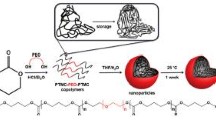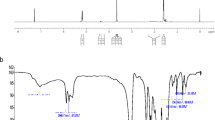Abstract
Biodegradability is a key feature for the application of polymeric devices in medicine. This study reports an experimental and theoretical study of the degradation of poly(thioether-ester) (PTEe) nanoparticles in aqueous media. The α,ω-diene diester derived from vegetable oil, 1,3-propylene diundeca-10-polenoate (Pd10e), was used as monomer in the solvent-free synthesis of Pd10e-based nanoparticles (A-PTEe nanoparticles) via thiol-ene miniemulsion polymerization. The theoretical partition coefficients of A-PTEe and a PTEe based on dianhydro-d-glucityl diundec-10-enoate (DGU) (B-PTEe nanoparticles) were calculated using density functional theory (DFT), in order to compare their degradation behavior. The results showed that A-PTEe is more hydrophilic than B-PTEe, thus indicating the possible faster degradation of the former. The experimental degradation studies showed that, in fact, A-PTEe nanoparticles are faster degraded than B-PTEe, presenting substantial molecular weight decrease, which confirms the theoretical results. The effects of degradation could be observed in the chemical composition and thermal properties of the polymer. Considering its applicability potential as a biomaterial due to its fast degradation behavior, the cytotoxicity of A-PTEe nanoparticles and its degradation products were evaluated. In vitro assays confirmed the biocompatibility of A-PTEe nanoparticles and its degradation products when exposed on fibroblasts and red blood cells. These results suggest A-PTEe nanoparticles can be promising candidates as biobased nanocarriers for biomedical applications.
Graphic Abstract









Similar content being viewed by others
References
Amass W, Amass A, Tighe B (1998) A review of biodegradable polymers: uses, current developments in the synthesis and characterization of biodegradable polyesters, blends of biodegradable polymers and recent advances in biodegradation studies. Polym Int 47:89–144. https://doi.org/10.1002/(SICI)1097-0126(1998100)47:2%3c89::AID-PI86%3e3.0.CO;2-F
Jasinski F, Lobry E, Tarablsi B et al (2014) Light-mediated thiol-ene polymerization in miniemulsion: a fast route to semicrystalline polysul fide nanoparticles. ACS Macro Lett 3:958–962. https://doi.org/10.1021/mz500458s
Amato DV, Amato DN, Flynt AS, Patton DL (2015) Functional, sub-100 nm polymer nanoparticles via thiol-ene miniemulsion photopolymerization. Polym Chem 6:5625–5632. https://doi.org/10.1039/c4py01449a
Machado TO, Sayer C, Araujo PHH (2017) Thiol-ene polymerisation: a promising technique to obtain novel biomaterials. Eur Polym J 86:200–215. https://doi.org/10.1016/j.eurpolymj.2016.02.025
Hoyle CE, Lee TY, Roper T (2004) Thiol-enes: chemistry of the past with promise for the future. J Polym Sci A 42:5301–5338. https://doi.org/10.1002/pola.20366
Türünç O, Meier MAR (2013) The thiol-ene (click) reaction for the synthesis of plant oil derived polymers. Eur J Lipid Sci Technol 115:41–54. https://doi.org/10.1002/ejlt.201200148
Machado TO, Cardoso PB, Feuser PE et al (2017) Thiol-ene miniemulsion polymerization of a biobased monomer for biomedical applications. Coll Surf B 159:509–517. https://doi.org/10.1016/j.colsurfb.2017.07.043
de Meneses AC, dos Santos PCM, Machado TO et al (2017) Poly(thioether-ester) nanoparticles entrapping clove oil for antioxidant activity improvement. J Polym Res. https://doi.org/10.1007/s10965-017-1353-x
dos Santos PCM, Machado TO, Santin JVC et al (2020) Superparamagnetic biobased poly(thioether-ester) via thiol-ene polymerization in miniemulsion for hyperthermia. J Appl Polym Sci. https://doi.org/10.1002/app.49741
Panyam J, Dali MM, Sahoo SK et al (2003) Polymer degradation and in vitro release of a model protein from poly(d,l-lactide-co-glycolide) nano- and microparticles. J Control Release 92:173–187. https://doi.org/10.1016/S0168-3659(03)00328-6
Hoelscher F, Machado TO, de Oliveira D et al (2018) Enzymatically catalyzed degradation of poly (thioether-ester) nanoparticles. Polym Degrad Stab 156:211–217. https://doi.org/10.1016/j.polymdegradstab.2018.09.007
Cardoso PB, Machado TO, Feuser PE et al (2018) Biocompatible polymeric nanoparticles from castor oil derivatives via thiol-ene miniemulsion polymerization. Eur J Lipid Sci Technol 120:1–8. https://doi.org/10.1002/ejlt.201700212
Hanwell MD, Curtis DE, Lonie DC et al (2012) Avogadro: an advanced semantic chemical editor, visualization, and analysis platform. J Cheminform 4:17. https://doi.org/10.1186/1758-2946-4-17
Chiaradia V, Soares NS, Valério A et al (2016) Immobilization of Candida antarctica lipase B on magnetic poly(urea-urethane) nanoparticles. Appl Biochem Biotechnol 180:558–575. https://doi.org/10.1007/s12010-016-2116-6
Chiou SH, Wu WT (2004) Immobilization of Candida rugosa lipase on chitosan with activation of the hydroxyl groups. Biomaterials 25:197–204. https://doi.org/10.1016/S0142-9612(03)00482-4
Feuser PE, dos Bubniak LS, do Bodack CN et al (2016) In vitro cytotoxicity of poly(methyl methacrylate) nanoparticles and nanocapsules obtained by miniemulsion polymerization for drug delivery application. J Nanosci Nanotechnol 16:7669–7676. https://doi.org/10.1166/jnn.2016.11610
Guindani C, Candiotto G, Araújo PHH et al (2020) Controlling the biodegradation rates of poly(globalide-co-ε-caprolactone) copolymers by post polymerization modification. Polym Degrad Stab. https://doi.org/10.1016/j.polymdegradstab.2020.109287
Garrido NM, Jorge M, Queimada AJ et al (2011) Using molecular simulation to predict solute solvation and partition coefficients in solvents of different polarity. Phys Chem Chem Phys 13:9155. https://doi.org/10.1039/c1cp20110g
Thurecht KJ, Heise A, Degeus M et al (2006) Kinetics of enzymatic ring-opening polymerization of ε-caprolactone in supercritical carbon dioxide. Macromolecules 39:7967–7972. https://doi.org/10.1021/ma061310q
Shih C (1995) Chain-end scission in acid catalyzed hydrolysis of poly (d,l-lactide) in solution. J Control Release 34:9–15. https://doi.org/10.1016/0168-3659(94)00100-9
Chen DR, Bei JZ, Wang SG (2000) Polycaprolactone microparticles and their biodegradation. Polym Degrad Stab 67:455–459. https://doi.org/10.1016/S0141-3910(99)00145-7
Baier G, Cavallaro A, Friedemann K et al (2014) Enzymatic degradation of poly(l-lactide) nanoparticles followed by the release of octenidine and their bactericidal effects. Nanomed Nanotechnol Biol Med 10:131–139. https://doi.org/10.1016/j.nano.2013.07.002
ISO/EN10993-5 (2009) B. Int Stand ISO 10993-5 Biol Eval Med devices—Part 5 Tests Cytotox Vitr methods, 3rd Ed. p 42
Psimadas D, Georgoulias P, Valotassiou V, Loudos G (2012) Molecular nanomedicine towards cancer. J Pharm Sci 101:2271–2280. https://doi.org/10.1002/jps
Acknowledgments
We gratefully acknowledge CAPES (Coordenação de Aperfeiçoamento de Pessoal de Nível Superior), especially to CAPES-PRINT Program (Project number 88887.310560/2018-00), and CNPq (Conselho Nacional de Desenvolvimento Científico e Tecnológico) for the financial support. G. Candiotto and C. Guindani gratefully acknowledge FAPERJ (Fundação Carlos Chagas Filho de Amparo à Pesquisa do Estado do Rio de Janeiro), process numbers E-26/200.008/2020 and E-26/201.911/2020, for the financial support. G. Candiotto also thanks the support of Núcleo Avançado de Computação de Alto Desempenho (NACAD/COPPE/UFRJ) and Sistema Nacional de Processamento de Alto Desempenho (SINAPAD).
Funding
CAPES (Coordenação de Aperfeiçoamento de Pessoal de Nível Superior), CAPES-PRINT Program (Project number 88887.310560/2018-00); CNPq (Conselho Nacional de Desenvolvimento Científico e Tecnológico) and FAPERJ (Fundação Carlos Chagas Filho de Amparo à Pesquisa do Estado do Rio de Janeiro) Process E-26/201.911/2020 and Process E-26/200.008/2020.
Author information
Authors and Affiliations
Contributions
FH: Investigation, methodology, writing—original draft, writing—review & editing. PBC: Investigation, concept development, writing—original draft. GC: Formal analysis, investigation, methodology, writing—original draft, writing—review & editing. CG: Formal analysis, concept development, methodology, writing—original draft, writing—review & editing. PF: Investigation—biological assays, methodology, writing—original draft. PHHA: Formal analysis, conceptualization, project administration, supervision, writing—review & editing. CS: Conceptualization, writing—review & editing, project administration, funding acquisition, supervision.
Corresponding author
Ethics declarations
Conflict of interest
The authors declare that they have no known competing financial interests or personal relationships that could have appeared to influence the work reported in this paper.
Additional information
Publisher's Note
Springer Nature remains neutral with regard to jurisdictional claims in published maps and institutional affiliations.
Supplementary Information
Below is the link to the electronic supplementary material.
Rights and permissions
About this article
Cite this article
Hoelscher, F., Cardoso, P.B., Candiotto, G. et al. In Vitro Degradation and Cytotoxicity Response of Biobased Nanoparticles Prepared by Thiol-ene Polymerization in Miniemulsion. J Polym Environ 29, 3668–3678 (2021). https://doi.org/10.1007/s10924-021-02139-w
Accepted:
Published:
Issue Date:
DOI: https://doi.org/10.1007/s10924-021-02139-w




